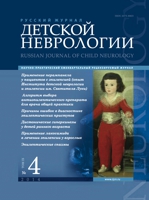ELECTROENCEPHALOGRAPHIC CHANGES WITH DRAVET SYNDROME
- Authors: Mukhin K.Y.1, Pylaeva O.A.1, Mironov M.B.1, Dolinina A.F.2, Morozov D.V.3, Nikitina M.A.1
-
Affiliations:
- Svt. Luka's Institute of Child Neurology and Epilepsy, 6 Svetlaya St., Puchkovo Settlement, Troitsk, Moscow, 143396, Russia
- Chelyabinsk Regional Children's Clinical Hospital, 42А Blucher St., Chelyabinsk, 454076, Russia
- Department of Pediatric Neurology, Kazan State Medical Academy, Ministry of Health of Russia, 11 Galeyev St., Kazan, 420139, Russia
- Issue: Vol 9, No 4 (2014)
- Pages: 6-13
- Section: AUTHENTIC ARTICLES
- Published: 19.04.2015
- URL: https://rjdn.abvpress.ru/jour/article/view/34
- DOI: https://doi.org/10.17650/2073-8803-2014-9-4-6-13
- ID: 34
Cite item
Full Text
Abstract
Dravet syndrome (DS, severe myoclonic epilepsy of early infancy) is epileptic encephalopathy with onset in the first year of life, manifested with febrile and afebrile generalized and focal seizures, with the presence of myoclonic paroxysms in typical cases, mental retardation, and resistance to antiepileptic therapy. The disease was for the first time described by Ch. Dravet in 1978 in France, then, in details, by Сh. Dravet et al. in 1982. In the classification of 1989, DS held a particular place being attributed to the forms of epilepsy that have both generalized and focal clinical manifestations. According to Proposed diagnostic scheme for people with epileptic seizures and with epilepsy (2001), this disease is attributed to epileptic encephalopathies of early infancy. The main reason of DS development is a mutation in the SCN1A gene revealed with most (but not all) patients. It is assumed that there are certain other mutations that determine DS development, in particular, the GABRG2 mutation. Polymorphism of epileptic seizures is typical of the DS: febrile seizures, focal motor (including hemiclonic and secondarily generalized), generalized tonic and clonic, alternating hemiconvulsions, myoclonic, atypical absences, focal dialeptic seizures, as well as epileptic status. The prognosis of the disease is severe. In most cases, seizures continue to occur in adult life but with lower frequency than in childhood. The authors review the issues of etiology and pathogenesis in details, as well as clinical manifestations, diagnostics, and treatment of the DS. A particular emphasis is given to pathological changes on electroencephalogram (EEG) of patients with DS. Distinct slowing of background activity, prevalence of multiregional epileptiform activity, regional slowing, and severe photosensitivity (pattern sensitivity) are the most prognostically unfavorable EEG patterns of the DS.
About the authors
K. Yu. Mukhin
Svt. Luka's Institute of Child Neurology and Epilepsy, 6 Svetlaya St., Puchkovo Settlement, Troitsk, Moscow, 143396, Russia
Author for correspondence.
Email: center@epileptologist.ru
Russian Federation
O. A. Pylaeva
Svt. Luka's Institute of Child Neurology and Epilepsy, 6 Svetlaya St., Puchkovo Settlement, Troitsk, Moscow, 143396, Russia
Email: fake@neicon.ru
Russian Federation
M. B. Mironov
Svt. Luka's Institute of Child Neurology and Epilepsy, 6 Svetlaya St., Puchkovo Settlement, Troitsk, Moscow, 143396, Russia
Email: fake@neicon.ru
Russian Federation
A. F. Dolinina
Chelyabinsk Regional Children's Clinical Hospital, 42А Blucher St., Chelyabinsk, 454076, Russia
Email: fake@neicon.ru
Russian Federation
D. V. Morozov
Department of Pediatric Neurology, Kazan State Medical Academy, Ministry of Health of Russia, 11 Galeyev St., Kazan, 420139, Russia
Email: fake@neicon.ru
Russian Federation
M. A. Nikitina
Svt. Luka's Institute of Child Neurology and Epilepsy, 6 Svetlaya St., Puchkovo Settlement, Troitsk, Moscow, 143396, Russia
Email: fake@neicon.ru
Russian Federation
References
Supplementary files






